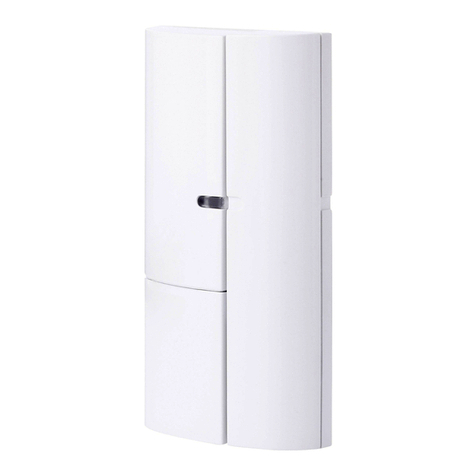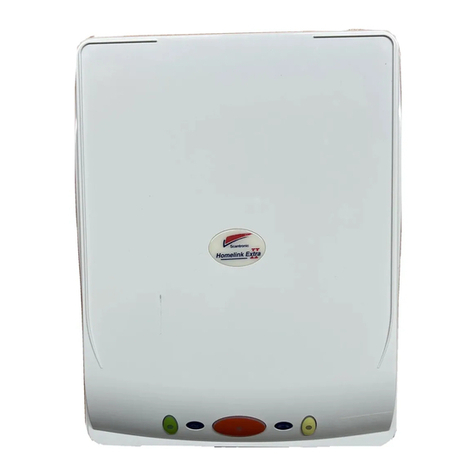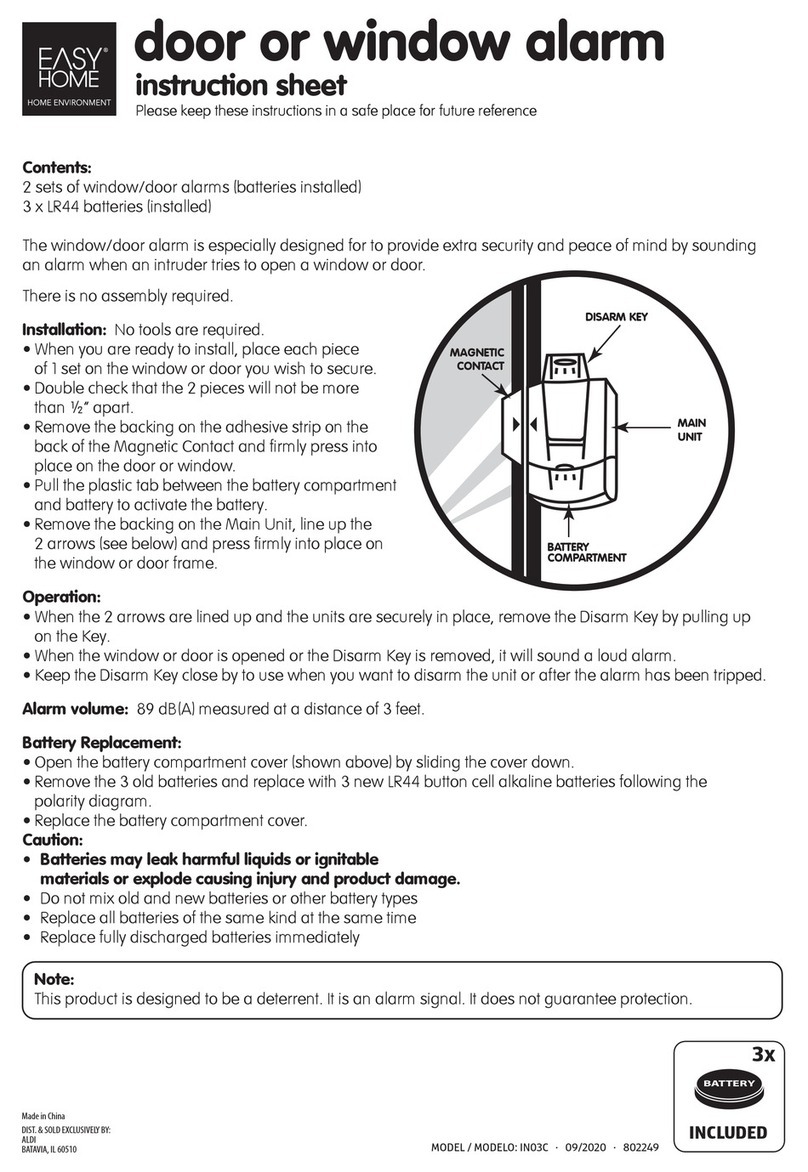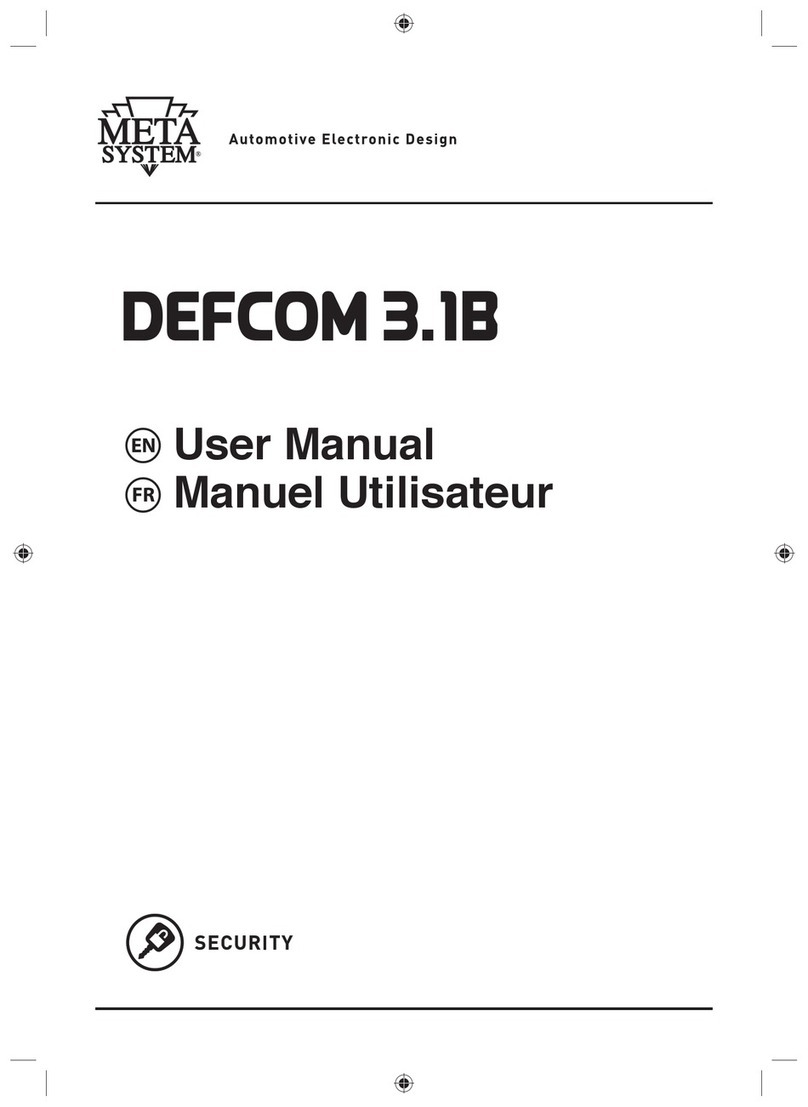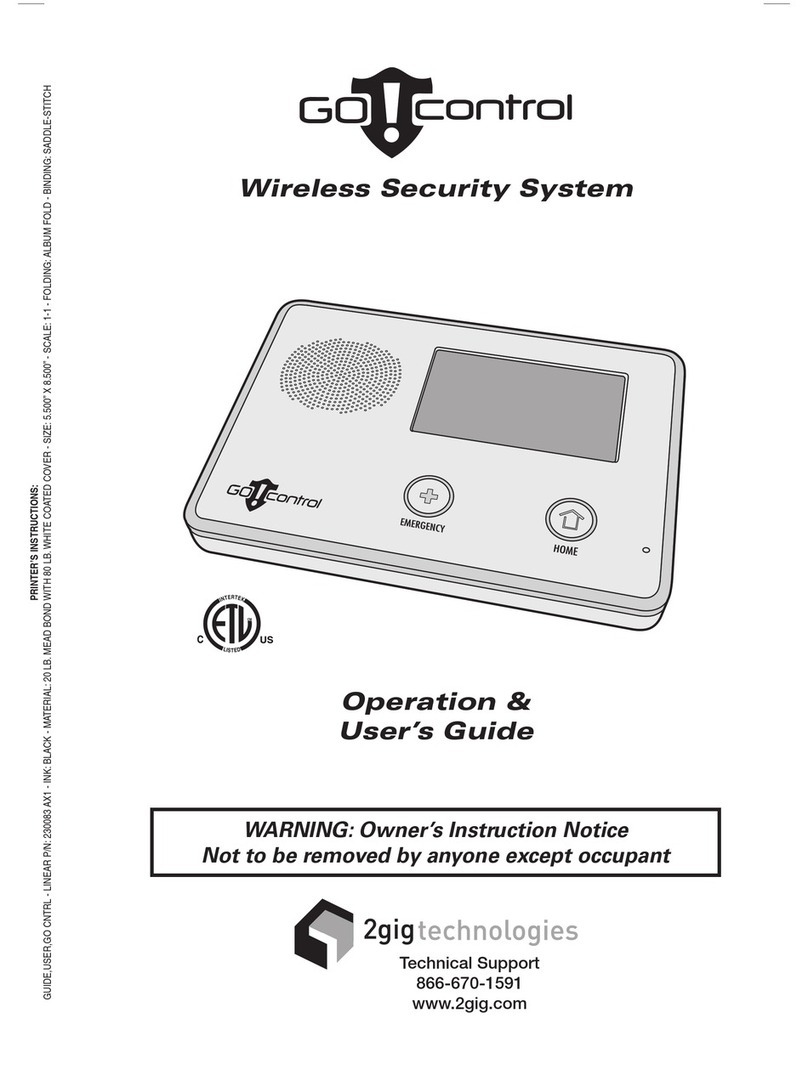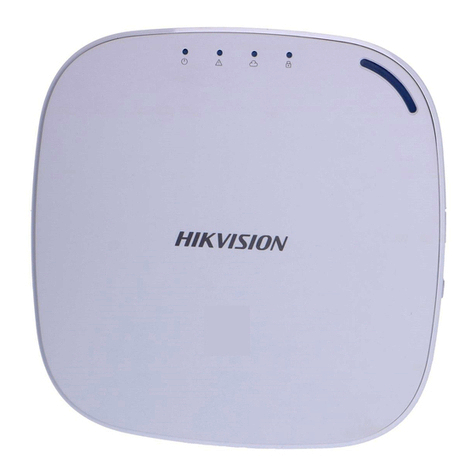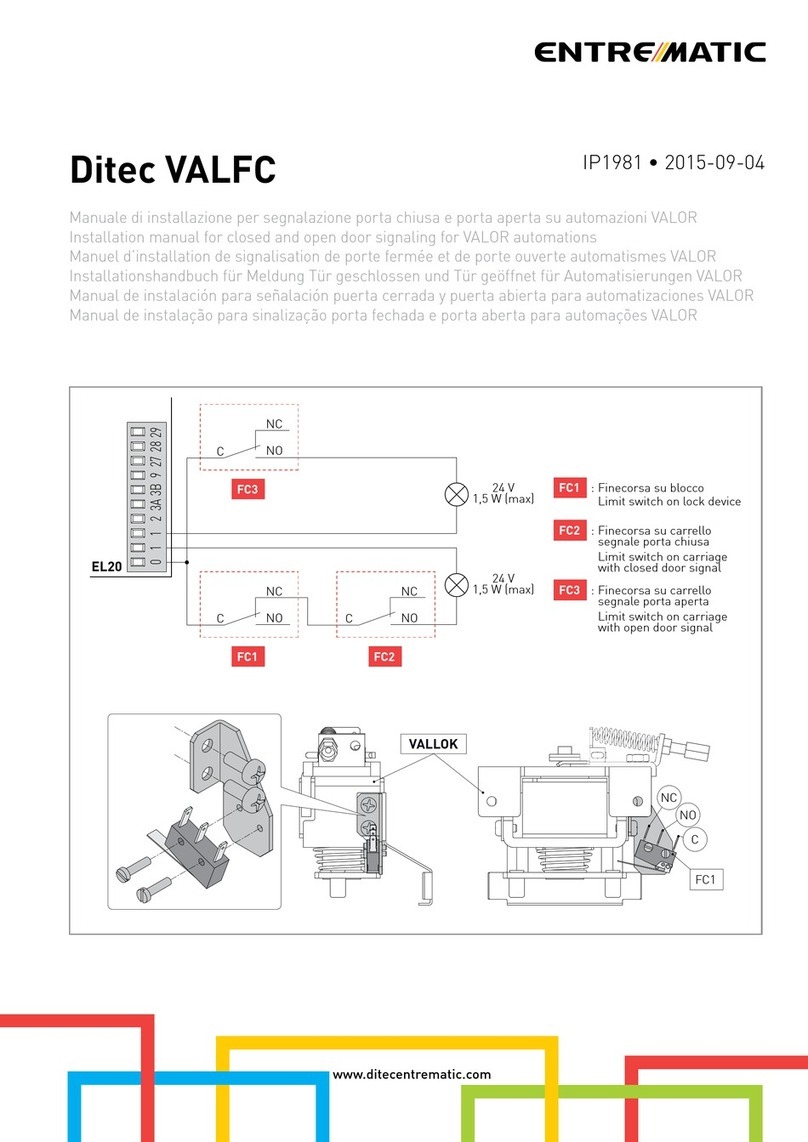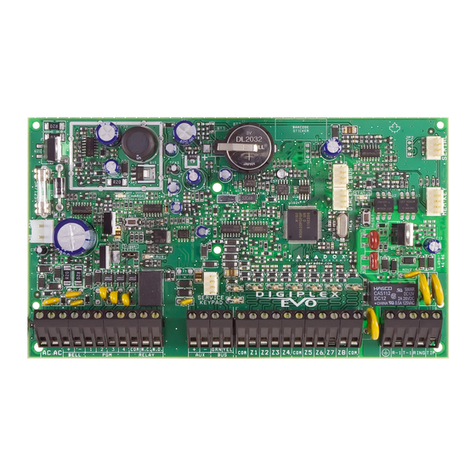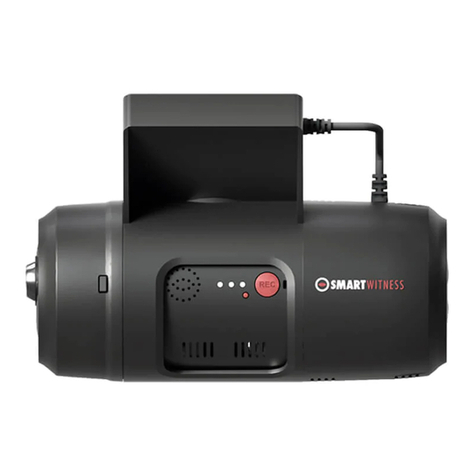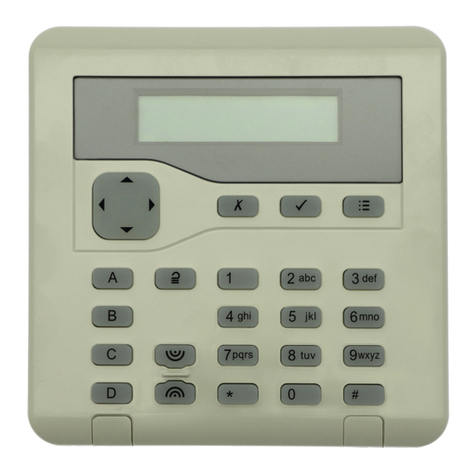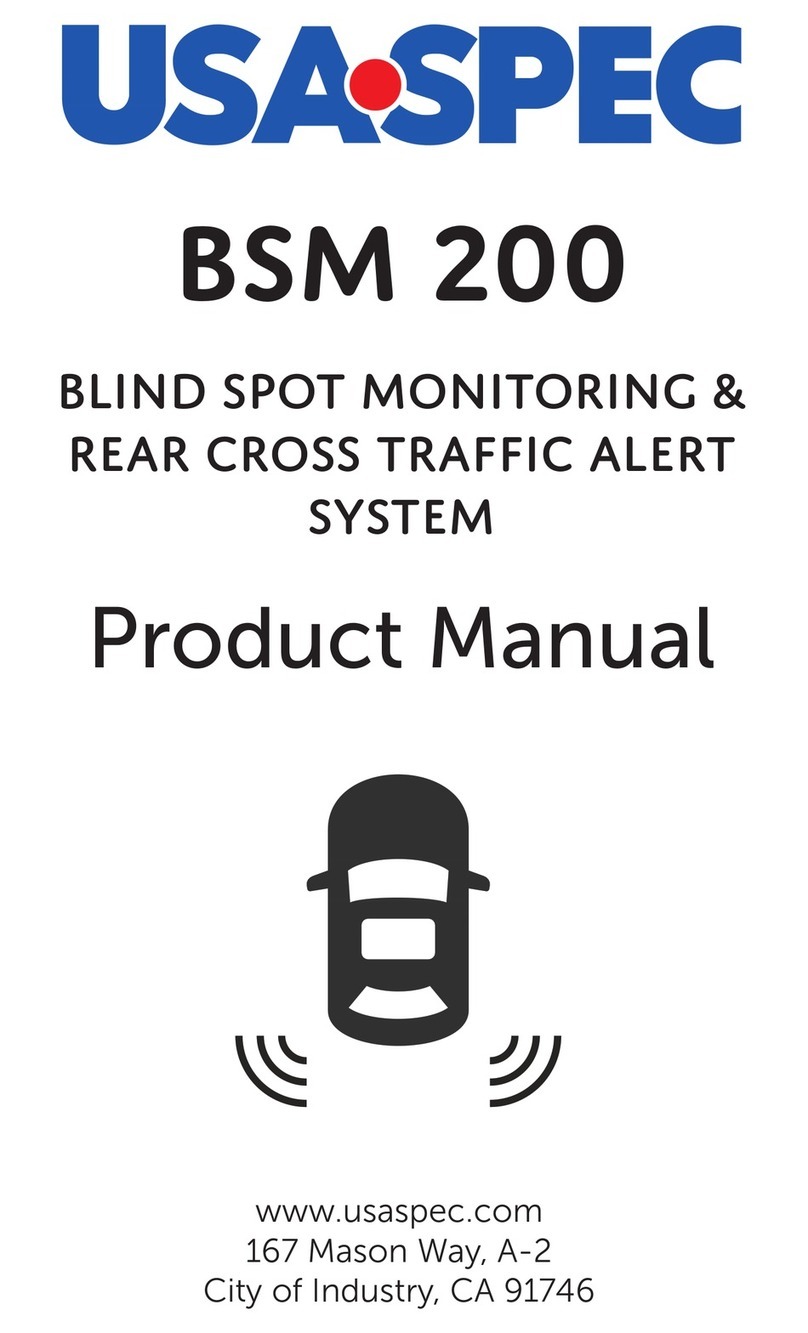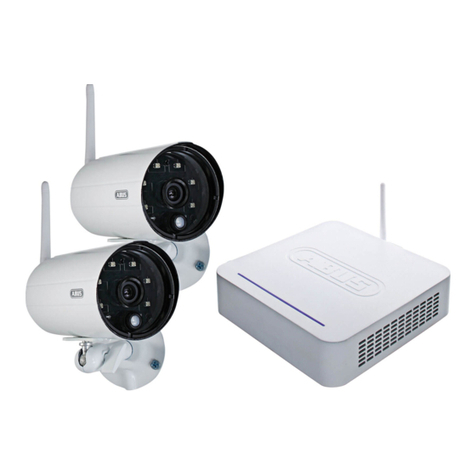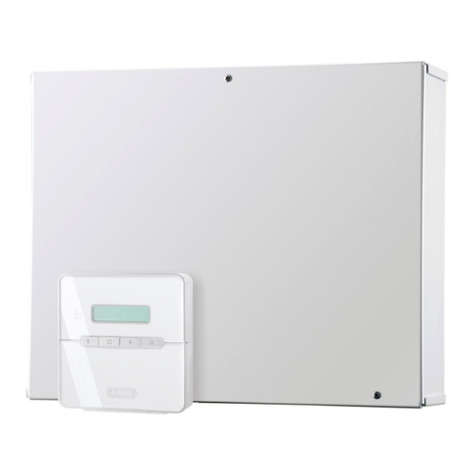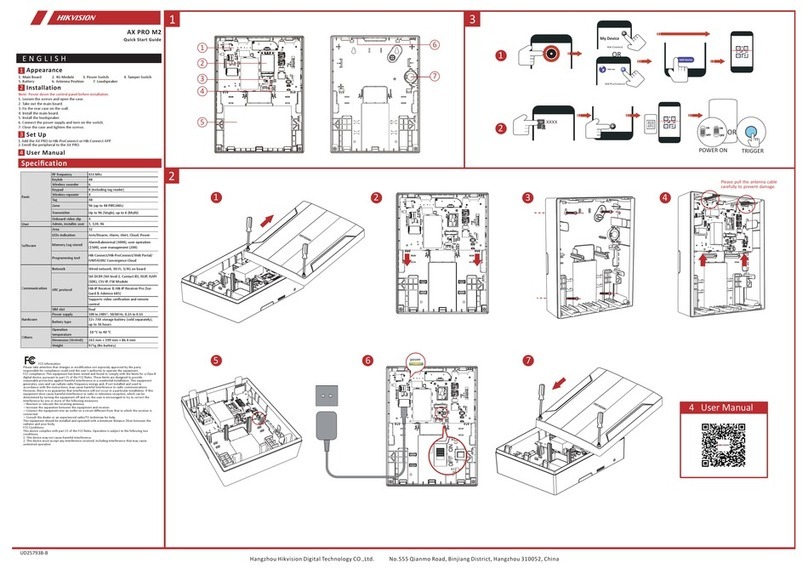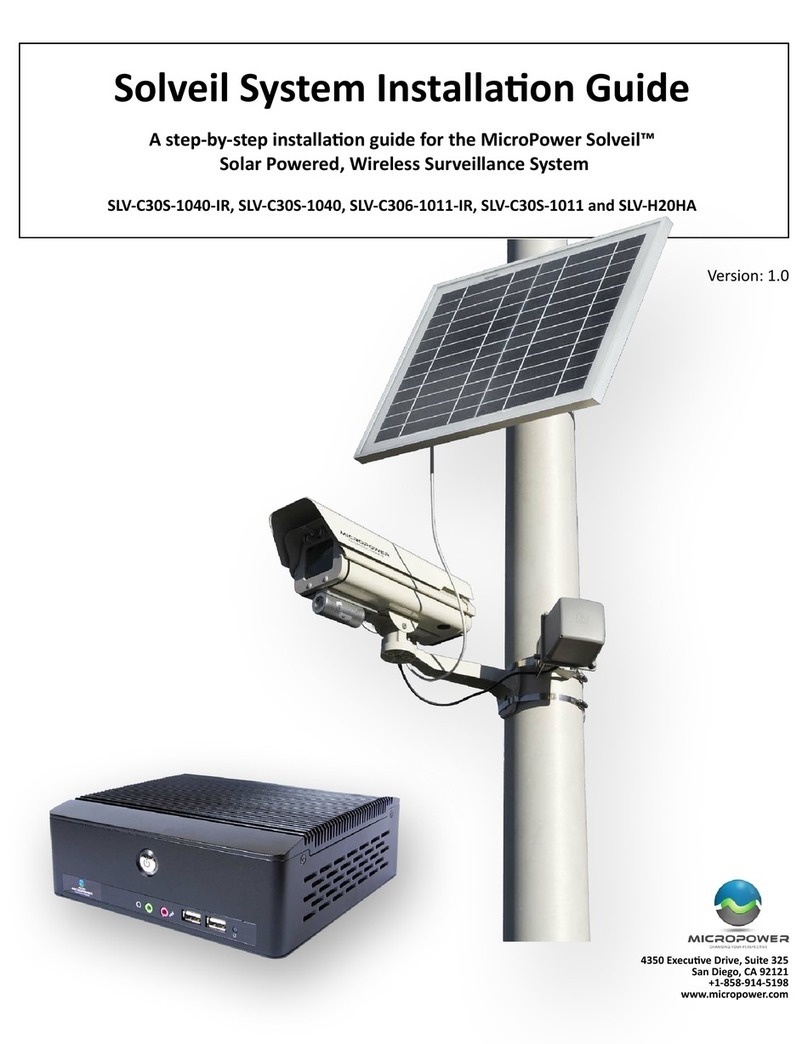United Technologies Interlogix ATS7120 Assembly instructions

© 2014 UTC Fire & Security Americas Corporation, Inc. 1 / 16 P/N 1070334 (ML) • REV A • ISS 04AUG14
ATS7120-7121 ISDN Dialler Installation Sheet
EN
NL
1
2
3
4
2
4 4
4 4
6
1
2
34
5
1
1
1
4
6
35
PSTN
NT1
RTTA
T '
S0' S0
ATS7100 ISDN
2
1

2 / 16 P/N 1070334 (ML) • REV A • ISS 04AUG14
5
EN: Installation Sheet
Introduction
General
This installation guide describes the installation of:
•ATS7120 ISDN B-channel dialler
•ATS7121 ISDN D-channel transmitter and integrated
ISDN B-channel dialler Installation and Troubleshooting
Guide
ISDN Definitions
ISDN (Integrated Services Digital Network) is a system of
digital phone connections that allows data to be transmitted
simultaneously across the world using end-to-end digital
connectivity.
With ISDN, voice and data are carried by bearer channels (B
channels) occupying a bandwidth of 64 Kbps (bits per second).
A data channel (D channel) handles signalling at 16 Kbps or
64 Kbps, depending on the service type. There are two basic
types of ISDN service: Basic Rate Interface (BRI) and Primary
Rate Interface (PRI).
•Basic Rate Interface (BRI): See Figure 3, item 1. BRI
consists of two 64 Kbps B channels and one 16 Kbps D
channel for a total of 144 Kbps. This basic service is
intended to meet the needs of most individual users.
•Primary Rate Interface (PRI): See figure 3, item 2. PRI is
intended for users with greater capacity requirements.
In Europe, PRI consists of 30 B channels plus one 64
Kbps D channel for a total of 1984 Kbps.
The ATS7120 and ATS7121 diallers are designed for use on
the BRI (ISDN-2).
Signalling
Instead of the phone company sending a ring voltage signal to
ring the bell in your phone ("In-Band signal"), it sends a digital
packet on a separate channel ("Out-of-Band signal"). The Out-
of-Band signal does not interfere with established connections.
No bandwidth is taken from the data channels and call setup
time is quick. An ISDN call setup usually takes less than
2 seconds.
The signalling also indicates who the caller is, what type of call
it is (data/voice), and what number was dialled. Available ISDN
phone equipment is then capable of making intelligent
decisions on how to direct the call.
Point to Multipoint Configuration (PTMP ATS7120 /
ATS7121)
PTMP configurations are most common in a standard BRI
ISDN network (also called ISDN-2).
The maximum number of ISDN terminals that can be
connected to a BRI line is eight.
Point to Point Configuration (PTP only for ATS7120)
PTP configurations are used when only one ISDN terminal is
connected to the ISDN network. In most cases, the connected
device will be a PABX.
Note: The ATS7120 must always be connected before the
PABX.
ISDN TEI values
It is possible to connect up to 8 devices to the ISDN S0 bus
(PTMP). The NT1 keeps track of these devices by using the
Terminal Endpoint Identifier (TEI). This TEI is an identification
number that can have the following values:
•0-63: Fixed TEI (programmed by user)
•64-126: Automatic TEI (assigned by the NT1)
•127: Group TEI (message from NT1 to all devices)
When using the ATS71xx in a Point-to-Multipoint configuration
for reporting using the analogue protocols (like SIA, Contact
ID), it will get a TEI value automatically. This TEI value can be
any value between 64 and 126.
In a Point-to-Point configuration there can only be one device
(application) on the bus, so there will be only one TEI value.
This TEI value for a Point-to-Point configuration is 0 (fixed).
For X25 over D-channel reporting, fixed TEI values are used.
The used values are country dependent.
TEI Value
Netherlands
Belgium
1, 11, 21
Digi-Access PIN (Interpay)
ISDN D-Watch
2, 12, 22
Digi-Access Alarm
ISDN-D Commerce
(BankSys)
3, 13, 23
Digi-Access Standard
IC3
RL2 RL1 CONN3
SpeakerA0
S0 MON
LED 3
LED 2
LED 1
MI LED
CONN4
ATS7100
1
2
34
5
6
7
8
9
10
11

P/N 1070334 (ML) • REV A • ISS 04AUG14 3 / 16
The first alarm device (default) on the S0 bus will get the TEI
value 1 (in Belgium) or 2 (The Netherlands), the second alarm
device (optional) will get the TEI value 11 (in Belgium) or 12 (in
Netherlands), etc. This TEI value needs to be programmed by
the installer in menu 19.9.
ATS7120
The ATS7120 uses the ISDN B-channel for communication
with the alarm processing system or for up and download
panel programming. The ATS7120 is designed for Point to
Multi Point configurations as well as Point to Point
configurations
ATS7121
The ATS7121 uses the ISDN D-channel for communication
with the alarm processing system.
The principle of D-channel communication in an intrusion
environment is related to a special service on a BRI ISDN line,
which will be provided by the local Telephone Company. This
service gives access to the so-called X-25 network and is
available in a number of countries of Europe, for example:
Netherlands:
Digi-Access Alarm
(300 bps)
Digi-Access Standard
(9600 bps)
Belgium:
D-Watch
(300 bps)
D-Watch Pro
(9600 bps)
The Central Station to which the ATS7121 will be connected
must order this special service. With this service the D-channel
can have access to a Closed User Group (CUG).
The X25 Enai protocol is able to use the X25 D-Bit. This
reduces the number of packets that is transmitted, and thus
transmission costs. The availability of this feature depends on
the network. Currently it is supported (X25 D-Bit set to Yes) in
the Netherlands. In Belgium the option X25 D-Bit shall be set
to No.
On parallel the ATS7121 has the possibility of using one ISDN
B-channel for up and download panel programming, or B-
channel alarm reporting to the Titan Management package.
One B-channel will always be available for other applications
such as phoning and faxing.
The alarm processing system receives alarms of the ATS7121
via an X.25 receiver.
The ATS7121 sends test reports continuously. If the X.25
receiver doesn’t receive the test reports anymore, a
communication fall-out is immediately passed on to the
processing system.
Encryption (ATS7121)
Messages to the alarm processing system are encrypted. Even
messages with the same contents will differ each time during
transportation.
EURO-ISDN Compliancy
The ATS7120/7121 ISDN complies with the CTR3 A1 (EURO-
ISDN) standard for the following usages:
•Automatic dialling
•Multiple repeat attempts
The ATS7120/7121 ISDN is also capable of the following:
•Automatic call initialization
•Automatic answering
Any usage other than those approved, or failure to comply with
the installation and programming instructions may invalidate
any approval given to the apparatus if, as a result, the
apparatus ceases to comply with the standards against which
approval was granted.
Connecting to ISDN
The ATS7120/7121 ISDN dialler is connected to the ISDN
network via an NT1 (Network Terminator 1). This NT1 is part of
the local Telephone Company equipment and therefore always
installed by that company. The physical connection between
the NT1 and the ATS7120/7121 ISDN is by a standard RJ45-
RJ45 cable, as described by the ISDN specifications.
Figure 4 legend
Item
Description
1
On site
2
Central station receiver
R
Termination resistor (2 x 100 Ω)
T
ISDN terminal (e.g. ISDN phone)
TA
Terminal adapter (e.g. ISDN to PSTN)
T’
e.g. PSTN phone
NT1
ISDN termination device
S0
Incoming ISDN from NT1
S0’
To other ISDN devices
Connecting to NT1
Usually an NT1 is equipped with two RJ45 outlets that can be
used simultaneously when connecting the ISDN terminals. For
security applications, however, the second outlet should never
be used. If the second RJ45 plug of the NT1 is used, the
priority switch of the dialler will not be able to guarantee a free
B-channel for the dialler as the priority switch only affects the
terminals connected to the S0 out connector of the dialler.
Connection built-up (ATS7120)
The ATS7120 can only make use of B-channel transmission
although the connections will be established by the D-channel.
A total of 4 central stations can be programmed, each
supporting a main telephone number and a back-up number.
Each central station can be configured for different areas and
alarm protocols. Even voice reporting is supported (see also
the installation manual of the optional voice module ATS7200).
Note: For more details, see the Advisor Master programming
manual.
Connection built-up (ATS7121)
The ATS7121 can make use of D-channel transmission as well
as of B-channel transmission for alternative reporting. For D-
channel transmission, a polling mechanism can be set to
90 seconds or 15 minutes.
When this polling mechanism fails, the central station takes
action to inform the customer.

4 / 16 P/N 1070334 (ML) • REV A • ISS 04AUG14
In this case even a B-channel connection can be established.
Meanwhile, the polling mechanism repeats until the connection
has come about.
Priority switching
If the ATS7120/7121 ISDN dialler is used in a configuration
with other ISDN equipment on the same S0 bus, a fax or
telephone could occupy both B-channels when the
ATS7120/7121 ISDN needs to transmit an alarm event.
Standard ISDN methods will not allow a B-channel to be freed
for the ATS7120/7121 to use.
Consequently, the current state of the active sessions on the
local S0 bus are stored in an internal database. The
ATS7120/7121 ISDN "knows" if there are any B-channels
available and also keeps a record of the current session
parameters, such as TEI, call reference value, and the send
and receive sequence numbers.
When both B-channels are occupied, the ATS7120/7121 ISDN
sends a disconnect signal on behalf of one of the connected
ISDN devices. The ISDN network will perform further
necessary actions. The disconnect signal will be sent for the
other device if there is still no connection after five seconds. If
there is no B-channel available after another delay of five
seconds, the dialler sends a disconnect signal for both devices.
When still no B-channel is available, a timeout will occur. As
soon as there is a B-channel available, the dialler will transmit.
After the last timeout, the ATS7120/7121 ISDN physically
disconnects the S0 bus from the other terminal equipment by
its internal relay and waits one minute for the network to
stabilize. It should now be possible to make a call. When the
last call has succeeded, the relay switches back to connect all
other devices to the S0 bus again.
Installation
Mounting location
ATS7120/7121 must be mounted inside an ATS panel housing.
WARNING: Electrocution hazard. To avoid personal injury or
death from electrocution, remove all sources of power and
allow stored energy to discharge before installing or removing
equipment.
Mounting the unit
Mounting ATS7120/7121 into an ATS2000/3000/4500
control panel
See Figure 1.
1. Place the clips in the square holes (item 4). Use metal
pillars when available.
2. Mount the ATS7120/7121 using screws.
3. Connect the ATS7120/7121.
Mounting the ATS7120/7121 into an ATS4000 control panel
See Figure 2.
1. Remove the screws (item 1) and lift off the control panel
PCB.
2. Place the extension pillars with the plastic rings on top of
the existing pillars (item 3).
3. Place the clips in the square holes (item 4).
4. Connect the ATS7120/7121.
5. Mount the ATS7120/7121 using the screws and extension
pillars (item 5).
6. Place the ATS control panel PCB back into its original
position and mount using screws.
Connecting the ATS7120/7121
1. Connect the flat cable (item 2) between the control panel
(connector J20) and the dialler (connector CONN1).
2. Connect the incoming ISDN line from the NT1 into
CONN3.
3. Connect the outgoing ISDN line to other ISDN devices into
CONN4.
4. Make 1 loop with the ISDN lines through the ferrite
(item 6).
Host power supply
The user must ensure that the power drawn by the
ATS7120/7121 ISDN, together with the host and any auxiliary
terminal equipment drawing power from the host is within the
rating of the host power supply.
MI address selection
ATS7120/7121 are addressable units, which can share the
panel bus (MI-bus) with other devices. The A0 jumper must be
placed on the two pins beside the RJ45 ISDN connections
(default) to have the correct address.
Connecting an ISDN terminal to the ATS7120/7121 ISDN
via the S0 out connector
It is possible to connect ISDN terminals to the ISDN line.
Connect all ISDN terminals to the outgoing S0 bus (CONN4).
If the ATS7120/7121 is the only ISDN device connected to the
NT1, then the ATS7120/7121 can terminate the S0 bus with
100 ohm resistors by placing the jumpers marked "TRM1 &
TRM2" on the RJ45 connector side of the jumpers. Never
place these jumpers, in case any other ISDN terminal is
connected to the outgoing ISDN connector (CONN4).
Caution: Never connect telephones in parallel (using the
second RJ45 connector on the NT1) with the ATS7120/7121
ISDN!
For security reasons, it is recommended that no devices be
connected to the second RJ45 connector of the NT1. Proper
priority switching is not possible in case the second RJ45 is
used.
Advice should be sought from a telecom telephone engineer if
in any doubt regarding the connection of these terminals.
ATS7120/7121 overview
See Figure 5.
Figure 5 legend
Item
Description
1.
CONN1, connects to ATS control panel.
2.
CONN3, RJ45 connector. Incoming ISDN from NT1.

P/N 1070334 (ML) • REV A • ISS 04AUG14 5 / 16
Item
Description
3.
CONN2, connects to other ATS devices.
4.
CONN4, RJ45 connector. Outgoing ISDN to other ISDN
devices.
5.
TRM1/TRM2 jumpers to set ISDN line termination.
6.
SPEAKER output, to monitor analogue communication.
7.
ADDR jumper. Used to set MI device address.
8.
ISDN status LEDs.
9.
MI LED, indicates MI communication status.
10.
SO MON connector. RS232 to PC to monitor ISDN signals.
11.
ATS7120/7121 Upgrade eprom socket.
12.
IOM Connector. For future expansion.
ATS7120/7121 LEDs
MI status LED
The MI status LED (green) displays the status of the
communication interface to the panel. The LED signals the MI
status as shown in the following table:
Table 1: MI status LED
Duty cycle
Rate (±10%)
Description
100%
–
Power ON (in case none of the cases
below are valid)
0%
–
No Power or Power Failure
25%
1 s
Initialisation OK, waiting for
communication
50%
1 s
Everything OK, communication running
75%
500 ms
Hardware failure
50%
250 ms
Failure in communication, waiting for re-
initialisation.
ISDN Status LEDs
Three red LED indicators are mounted on the ATS7120/7121
ISDN PCB. The indicators give the installer information about
the current line status, call progress, and possible errors.
During normal operation, the indicators are either on, off,
blinking, or flashing. Blinking means 1 second on, 1 second off
and so on. Flashing means 0.1 seconds on and 0.9 seconds
off.
When the indicators are blinking in sequence after each other,
at a time interval of 0.5 seconds, a hardware error is present
and the ATS7120/7121 is in factory diagnostics mode.
Table 2: ATS71xx status LEDs
LED
LED 1, Status
LED 2, Call Status
(B-channel)
LED 3, X25 Call
Status [1]
Off
Hardware failure
Offline
Offline
Flash
Operational [2]
Call setup in
progress [2]
Call setup in
progress [2]
Blink
Local S0 bus
failure
Incoming call
present
Pause before
reconnect
On
Line fault,
network failure
Online
Online
[1] ATS7121 only.
[2] A running light on all the three LEDs indicates the unit is
initialising.
S0 Mon LED
The S0 Mon LED is on when the ATS7121 is transmitting
events via the ISDN D-Channel. During this (short)
transmission the S0 Monitor serial port is temporary switched
off. All data is buffered and will be displayed when the port is
available again.
Programming the ATS7120
The minimum programming settings for the ATS7120 are:
Table 3: ATS7120 minimum settings
Menu
Description
Comments
19.9
Reporting format
Per Central Station
19.9
Phone number 1
Per Central Station
19.9
System account
number
Per Central Station
19.9
Area account number
Per Central Station and Area
19.9
Select ISDN dialler
Per Central Station
19.9
Connection type
1 –ISDN
Per Central Station
For Panel firmware V04.00.00 and
higher
For further programming details see the Advisor Master
programming manual.
Programming ATS7121
The minimum programming settings for ATS7121 are:
Table 4: ATS7121 minimum settings
Menu
Description
Comments
19.9
X25 TEI value
Belgium: 1
Netherlands: 2
19.9
X25 D-Bit
Belgium: No
Netherlands: Yes
19.9
Reporting format
X25 ENAI
Per Central Station
19.9
Phone number 1
Per Central Station
19.9
System account
number
Per Central Station
19.9
Area account number
Per Central Station and Area
19.9
Select ISDN dialler
Per Central Station
19.9
X25 Account Code
Per Central Station
19.9
Connection type
2 –ISDN-D
Per Central Station
For Panel firmware V04.00.00 and
higher
For further programming details see the Advisor Master
programming manual.
Country dependent settings:
The X.25 TEI Value and X.25 D-Bit value are country
dependent, and are explained in chapters “General” on page 2
and “ATS7121” on page 3. The phone number will be provided
by the Central Station. This will be a number that gives access
to the X.25 network. In the Netherlands, these numbers start
with the digits 0204, in Belgium with 1206. The system and
area account numbers are provided by the Central Station.

6 / 16 P/N 1070334 (ML) • REV A • ISS 04AUG14
These have the same meaning as when reporting in the
analogue reporting formats like SIA and CID. The X25 Account
Code (4 or more digits) identifies the dialler, and is also
provided by the Central Station. It is also referred to as a
SubUnit Number (lowest 3 digits, range 1 to 250) and Unit
Number (other digits, range 1 to 9999). Example: Unit Number
34 and SubUnit Number 213 give X25 Account code 34213.
Using Titan
In general no events will be reported to the Central Station
while Titan is on-line to the panel. Due to shared resources
some limitations apply when connecting Titan to a system to
which an ATS7121 is connected.
When Titan is used via J18 using the ATS1630 cable, no
events can be reported via D-Channel X25 as long as the
cable is connected. Disconnect cable from panel when ready.
Start a local J18 Titan connection by typing * <installer code>
Enter, select “7 Service menu”. Do not select installer menu
19, since doing so initiates the transmission of the LB event.
When the ATS1630 cable is already connected, the ATS7121
will not be able to transmit this event, and both event reporting
and Titan are blocked.
When the Digi-Access/D-Watch service on the ISDN line is not
yet available / activated, the ATS7121 will keep on trying to
contact the Central Station. Thus at that moment it is not
possible to start a Titan connection via J18. In order to be able
to start Titan via J18 in such an occasion, the protocol for this
Central Station has to be set to “0 - Disabled”using the RAS,
and the system has to be powered down and up again. When
the Titan connection via J18 is no longer needed, or the Digi-
Access/D-Watch service on the ISDN line is activated, the
protocol can be set back to “12 - X25 Enai”.
Line monitor/guard (ATS7120 and ATS7121 in B-channel
mode)
The line monitor is activated by setting the menu "Enable ISDN
line fault monitor" to "Yes" (see “19.9 Communication options”).
If enabled, the ATS7120/7121 ISDN checks whether the S0
bus is activated or not. If the S0 bus is not activated, it will
initiate an activate request to the network and wait for
180 seconds for the S0 bus to be activated. If there is no
response from the network, the ATS7120/7121 ISDN
disconnects the outgoing S0 bus (CONN4) from the network by
its internal relay and initiates another activate request to the
network.
If there is still no response, the network has failed. The
ATS7120/7121 ISDN will then report a line fault to the panel.
The outgoing S0 bus was probably not the cause of the line
fault and will therefore be re-connected to the network. The
ATS7120/7121 ISDN keeps trying to activate until the network
is back.
However, if the network does respond after disconnecting the
outgoing S0 bus (CONN4), the outgoing S0 bus caused the
line fault. The ATS7120/7121 ISDN keeps the outgoing S0 bus
disconnected to ensure proper operation. From then on it will
reconnect the outgoing S0 bus every hour to test whether the
S0 bus problem has been solved or not. This state will be
remained until the S0 bus is operational. As it is still possible to
transmit alarm events, there will be no line fault reporting to the
panel.
Troubleshooting
•LEDs indicating operation/trouble mode (see Tables 1
and 2).
•Speaker connector
•A troubleshooting menu, accessible through the 4-pin
RS232 connector S0 Mon (use cable ATS1630).
Speaker
By connecting a speaker to the ATS7120/7121 (see
“ATS7120/7121 overview” on page 4) it is possible to listen to
calls that are made by the dialler using the analogue protocols
(SIA, Contact ID, etc). Any speaker with an impedance of at
least 32 Ωcan be used. As soon as the dialler is on-line with
the Central Station (LED 2 is on), the speaker is switched on,
and it is possible to listen to the alarm protocol to check if the
reports are acknowledged by the Central Station.
Main menu
The ATS7120/7121 ISDN generates a status and diagnostics
menu on any serial terminal (9600 bps, 8 data bits, no parity,
1 stop bit, no flow control) connected to its serial port via an
optional cable ATS1630. On a PC programs like the Windows
HyperTerminal or Telix can be used.
The default password code is 7812 and cannot be changed.
Figure 1 shows the menu screen. Typing a space character to
the ATS7120/7121 ISDN updates this screen. Any S0 bus D-
channel activity will be displayed while logged in. Always
logout by pressing the “l”key before disconnecting the serial
terminal.
Engineer menu
---------- SECURITY - ARITECH ---------
ATS7120/7121 ISDN V1.00.16.021 Jul 19 2004
EPROM 07a8 RAM c379 HW 0
Login level: 1 MI Address: 34
[l] logout
States - A: 0 –B: 0 - X: 6
Line status 0
S0 out enabled
S0 bus activity
Session 1 free
Session 2 free
------------------------------------------
The first line shows the product type (ATS7120 or ATS7121),
the version and the release date of the software. The next line
gives the checksum of EPROM and RAM calculated during
power up. HW shows the hardware status, and should always
be 0. The login level: 1 on the third line indicates that you have
engineer access rights to the dialler. Also the MI address is
shown. This address is read from the A0 jumper at power-up,
which must be placed as indicated in Figure 5, item 8. The
value must match the one specified in the following table:
Table 5: MI address
Product type
MI Address
ATS7120
30
ATS7121
34
[l] Log out: Typing “l”will log out the engineer. Always log out
before disconnecting the serial cable.

P/N 1070334 (ML) • REV A • ISS 04AUG14 7 / 16
The next lines show some diagnostics:
•A state: State of the main dialler process. Should be 0 if
there are no activities
•B state: State of the alarm transmission protocol. Should
be 0 if offline.
•X state: State of the X-25 alarm transmission protocol.
Should be 0 if offline (ATS7121 only).
Line status: Indicates the status of the S0 bus line monitor:
•0: activated
•1: try to activate
•2: try to activate S0 bus switched off
•3: testing network
•4: network failure
•5: local S0 in bus failure
•6: check local S0 bus
•7: check NT
S0 bus activity: Indicates the active sessions on the local S0
bus.
ISDN D-channel monitoring
While one is logged in to the ATS7120/ATS7121, the layers 2
and 3 D-channel messages will be displayed. This is a
powerful engineering tool for the installer and service engineer
that provides help in tracing the causes of equipment
malfunction. A minimum level of knowledge on the ISDN D-
channel messages is required to take full advantage of this
facility.
If the terminal is connected during power up, the user is able to
monitor the power up process. After power up the user can log
in the ATS7120/7121 ISDN by entering the default engineer
code 7812 followed by <CR>.
The following figure shows an example of an ISDN trace:
ISDN D-channel trace of a call from the ATS7120 to a
Central Station
Usr 064 INFO 020 029
cr=0010 SETUP 23
Net 064 INFO 029 021
cr=0010 CALL PROC
Usr 064 RR 030
Net 065 RR 015
Net 064 INFO 030 021
cr=0010 ALERTING
Usr 064 RR 031
Net 064 INFO 031 021
cr=0010 CONNECT
Usr 064 RR 032
Net 065 RR 015
Net 064 RR 021
Usr 064 RR 032
Net 065 RR 015
Net 064 INFO 032 021
cr=0010 DISCONNECT
Usr 064 RR 033
Usr 064 INFO 021 033
cr=0010 RELEASE
Net 064 INFO 033 022
cr=0010 RELEASE COM
Usr 064 RR 034
ISDN D-channel X25 monitoring (ATS7121 mode)
The ATS7121 will also display the X25 traffic on the D-channel,
together with the normal ISDN messages. This is a powerful
tool that can be used for troubleshooting. Typically the first
establishment of a connection will look as follows:
--> 48244
Usr 002 SABME
Net 002 UA
Net 002 INFO 000 000
LCN 0 RESTART REQ Cause 07 Diag 00
Usr 002 RR 001
Usr 002 INFO 000 001
LCN 0 RESTART REQ Cause 00 Diag 00
Usr 002 INFO 001 001
LCN 1 CALL REQ
Net 002 RR 001
Net 002 RR 002
Net 002 INFO 001 002
LCN 1 CALL ACCEPT
Usr 002 RR 002
! Connected
Usr 002 INFO 002 002
LCN 1 DATA
Net 002 RR 003
Net 002 INFO 002 003
LCN 1 RESET REQ Cause 80 Diag 00
Usr 002 RR 003
Usr 002 INFO 003 003
LCN 1 RESET CONF
Usr 002 INFO 004 003
LCN 1 DATA
Net 002 RR 004
Net 002 RR 005
Net 002 INFO 003 005
LCN 1 RESET REQ Cause 80 Diag 01
Usr 002 RR 004
Usr 002 INFO 005 004
LCN 1 RESET CONF
Usr 002 INFO 006 004
LCN 1 DATA
Net 002 RR 006
Net 002 RR 007
Net 002 INFO 004 007
LCN 1 RESET REQ Cause 80 Diag 02
Usr 002 RR 005
Usr 002 INFO 007 005
LCN 1 RESET CONF
Usr 002 INFO 008 005
LCN 1 DATA
Net 002 RR 008
Net 002 RR 009
Net 002 INFO 005 009
LCN 1 RR
Usr 002 RR 006
! TX Response (OK)
Usr 002 INFO 009 006
LCN 1 DATA
Net 002 RR 010
Net 002 INFO 006 010
LCN 1 RR
Usr 002 RR 007
! TX Response (OK)
Usr 002 INFO 010 007
LCN 1 DATA
Net 002 RR 011
Net 002 INFO 007 011
LCN 1 RR
Usr 002 RR 008
! TX Response (OK)
Usr 002 INFO 011 008
LCN 1 DATA
Net 002 RR 012
Net 002 INFO 008 012
LCN 1 RR
Usr 002 RR 009
! TX Response (OK)
Usr 002 RR 009
Net 002 RR 012
The following messages can be displayed by the dialler:
Message
Description
! Connected
The dialler is connected to the Central Station

8 / 16 P/N 1070334 (ML) • REV A • ISS 04AUG14
Message
Description
! Connect Failed
The dialler could not establish a connecting to
the Central Station. Please check the phone
number. See also the next tables for more
detailed information.
! Disconnected
The dialler is disconnected from the Central
Station
! TX Response (OK)
The message was transmitted successfully to
the Central Station
Calls may fail for several reasons. These are described below.
When the message SABME is shown for 4 times on the S0
Monitor, followed by the message !Connect Failed, this may be
caused by:
S0 Monitor shows
Possible reasons
Solution
Usr 002 SABME
Usr 002 SABME
Usr 002 SABME
Usr 002 SABME
! Connect Failed
No ISDN line connected
to the dialler
Incorrect TEI value
programmed
No X25 (Digi Access
Alarm service in the
Netherlands) is present
on the ISDN line
Connect ISDN line
Check menu
19.9.11 X25 TEI
Value
Contact Central
Station or PTT
When the X25/Digi Access Alarm (Netherlands) service is
present on the ISDN line, but a connection cannot be
established, the dialler will display Cause and Diagnostic
values to indicate the reason for the problem.
Cause
Diag
Reason
Solution
80
00
No problem. The scrambling
algorithm is synchronizing
and resends the message.
-
80
01
No problem. The scrambling
algorithm is synchronizing
and resends the message.
-
80
02
No problem. The scrambling
algorithm is synchronizing
and resends the message.
-
0B
46
No access to the Closed
User Group.
Contact the Central
Station
09
00
Central Station is off-line.
Contact Central
Station
09
8D
The connection to the
Central Station is Out of
Order.
Contact Central
Station or PTT
47
Line is busy; connection to
Central Station is not
available.
Check the phone
number
Contact the Central
Station
07
00
No problem. The line is
restarting.
-
00
00
No problem. The line is
restarting.
-
Firmware update
The ATS7120/ATS7121 firmware is stored in a flash memory
on the board. The recommended way to update this firmware
is by placing an EPROM/flash into the upgrade socket on the
board, that will then be copied into the on-board flash memory.
The procedure is as follows:
1. Power down the ATS7120/ATS7121
2. Insert the upgrade EPROM/flash into the upgrade socket
(IC26)
3. Position the jumpers FLASH 4 Mb and EPROM 4 Mb
according the diagram that can be found in the Release
Notes document accompanying the firmware update.
4. Power up the ATS7120/ATS7121
The ATS7120/ATS7121 will detect the EPROM/flash, and
will start the update procedure. The process can be
followed by looking at the LEDs. The LEDs indicate the
following steps:
•LED L1: Validity check.
•LED L2: Flash erase.
•LED L3: Flash program.
•LED MI (Green): Flash Verify.
LED on indicates that the step was successful. A blinking
LED indicates that there was a problem during this step.
When the green MI LED goes on, the copy process has
completed.
5. Power down the ATS7120/ATS7121.
6. Remove the EPROM/FLASH from the upgrade socket
(IC26).
7. Power back on the ATS7120/ATS7121.
Note: Always check the release notes of the firmware for the
required jumper settings for this specific firmware.
Specifications
ISDN specifications
ISDN interface
Complies with CTR3 A1 (EURO-ISDN)
B-Channel operates on
ISDN2, Point-to-Point and Point-to-
Multipoint
D-Channel operates on
ISDN2, Digi Access Secure (X-25 protocol)
on D-watch
Power supply specifications
Supply voltage
12 VDC via ribbon cable from control panel
Current consumption
120 mA (normal operation)
180 mA max. (during priority switching)
Connections
CONN1
MI-Bus connection to control panel via
ribbon cable for communication and
powering the module.
CONN2
MI Bus for daisy chaining other modules like
ATS1510 Audio Listen In and ATS7200
Voice module.
CONN3
RJ45, incoming ISDN S0 bus from NT1.
CONN4
RJ45, outgoiing ISDN S0’ bus to other ISDN
devices.
S0 MON
RS232, 4-pin connector to PC for S0
monitor.
SPEAKER
8 ohm speaker output
Jumpers/Settings
TRM1
ISDN line termination
TRM2
ISDN line termination

P/N 1070334 (ML) • REV A • ISS 04AUG14 9 / 16
ADDR
MI device address
FLASH 4Mb
Selects between 2Mb and 4Mb Flash
memory for the upgrade socket
EPROM 4Mb
Selects between 2Mb and 4Mb Eprom
memory for the upgrade socket
General Features Specifications
Operating temperature
10 to 50°C
Dimensions
175 x 90 x 20mm
Regulatory information
Manufacturer
UTC Fire & Security Americas Corporation, Inc.
3211 Progress Drive, Lincolnton, NC, 28092, USA
Authorized EU manufacturing representative:
UTC Fire & Security B.V.
Kelvinstraat 7, 6003 DH Weert, Netherlands
Certification
European
Union
directives
1999/5/EC (R&TTE directive): Hereby, UTC Fire &
Security declares that this device is in compliance with
the essential requirements and other relevant
provisions of Directive 1999/5/EC.
2002/96/EC (WEEE directive): Products marked with
this symbol cannot be disposed of as unsorted
municipal waste in the European Union. For proper
recycling, return this product to your local supplier
upon the purchase of equivalent new equipment, or
dispose of it at designated collection points. For more
information see: www.recyclethis.info.
Contact information
www.utcfireandsecurity.com or www.interlogix.com
NL: Installatie instructies
Introductie
Algemeen
Deze handleiding beschrijft de installatie van de:
•ATS7120 ISDN B-kanaal kiezer
•ATS7121 ISDN D-kanaal transmitter en geïntegreerde
ISDN B-kanaal kiezer
ISDN Definities
ISDN (Integrated Services Digital Network). Is een systeem
voor digitale telefoonverbindingen welke het mogelijk maakt
data te versturen over de gehele wereld waarbij gebruik wordt
gemaakt van end-to-end digitale apparatuur.
Bij ISDN worden spraak en data getransporteerd op een
dragerkanaal (B-kanaal) dat een bandbreedte heeft van 64
Kbps (bits per seconde). Een datakanaal (D-kanaal) wordt
gebruikt voor signalering met 16 Kbps of 64 Kbps, afhankelijk
van het type dienst. Er bestaan twee basisdiensten voor ISDN:
Basic Rate Interface (BRI) en Primary Rate Interface (PRI).
•BRI (Basic Rate Interface): Zie Figuur 3, item 1. BRI bevat
twee 64 Kbps B kanalen en één 16 Kbps D kanaal, totaal
144 Kbps. Deze dienst vervult daarmee de wensen voor
de individuele gebruikers.
•PRI (Primary Rate Interface): Zie Figuur 3, item 2. PRI is
bedoeld voor gebruikers met hoge capaciteitseisen. In
Europa bevat PRI 30 B kanalen en één 64 Kbps D kanaal,
totaal 1984 Kbps.
De ATS7120 en ATS7121 alarmkiezers zijn ontwikkeld voor
gebruik met BRI (ISDN-2).
Signalering
In plaats van het sturen van een belsignaal door een
telefoonbedrijf om de telefoon te laten overgaan ("In-Band
signaal"), wordt een digitaal datapakket verstuurd op een apart
kanaal ("Out-of-Band signaal"). Het Out-of-Band signaal
beïnvloedt bestaande verbindingen niet. Er wordt geen
bandbreedte afgenomen van de datakanalen en gesprekken
worden snel gemaakt. Een ISDN gesprek is normaal binnen 2
seconden opgebouwd.
Via signalering wordt ook aangegeven wie de beller is, welk
type gesprek het is (data/spraak) en welk nummer is gekozen.
Beschikbare ISDN telefoonapparatuur is daardoor in staat
intelligente beslissingen te maken hoe het gesprek door te
verbinden.
Point to MultiPoint Configuratie (PTMP ATS7120/ATS7121)
PTMP configuraties zijn het meest gebruikelijk in een
standaard BRI ISDN netwerk (ook ISDN-2 genaamd).
Het maximaal aantal ISDN terminals die kan worden
aangesloten op een BRI lijn is acht.
Point to Point Configuratie (PTP alleen voor ATS7120)
PTP configuraties worden gebruikt wanneer slechts één ISDN
terminal aangesloten is op het ISDN netwerk. In de meeste
gevallen is het aangesloten apparaat een PABX.
Opmerking: De ATS7120 moet altijd voor de PABX worden
aangesloten.
ISDN TEI waarden
Het is mogelijk maximaal 8 apparaten aan te sluiten op de
ISDN S0 bus (PTMP). De NT1 houdt een lijst bij van deze
apparaten door gebruik te maken van de Terminal Endpoint
Identifier (TEI). Deze TEI is een identificatie nummer dat de
volgende waarden kan aannemen:
•0-63: Vaste TEI (geprogrammeerd door gebruiker)
•64-126: Automatische TEI (Toegekend door NT1)
•127: Groep TEI (bericht van NT1 naar alle app.)
Bij gebruik van de ATS71xx in een Point to MultiPoint
configuratie voor doormelding door gebruik te maken van
analoge protocollen (zoals SIA, Contact ID), wordt automatisch
een TEI waarde verkregen. Deze TEI waarde is een getal
tussen 64 en 126.
In een Point to Point configuratie kan slechts één apparaat
(applicatie) op de bus, daarom is er slechts één TEI waarde.
Deze TEI waarde voor een Point to Point configuratie is 0
(vast).
Voor X.25 over D-kanaal doormelding worden vaste TEI
waarden gebruikt. De gebruikte waarden zijn landafhankelijk.
TEI Waarden
Nederland
België
1, 11, 21:
Digi-Access PIN (Interpay)
ISDN D-Watch
2, 12, 22
Digi-Access Alarm
ISDN-D Commerce
(BankSys)

10 / 16 P/N 1070334 (ML) • REV A • ISS 04AUG14
TEI Waarden
Nederland
België
3, 13, 23
Digi-Access Standaard
Het eerste alarm apparaat (standaard) op de S0 bus krijgt TEI
waarde 1 (in België) of 2 (in Nederland) toegewezen, Het
tweede alarm apparaat krijgt TEI waarde 11 (in België) of 12
(in Nederland), etc. Deze TEI waarde moet door de installateur
worden geprogrammeerd in menu 19.9.
ATS7120
De ATS7120 gebruikt de ISDN B-kanalen voor communicatie
met de particuliere alarmcentrale of voor up- en downloaden
van paneelprogrammering. De ATS7120 is ontwikkeld voor
zowel Point to Multi Point configuraties als voor Point to Point
configuraties
ATS7121
De ATS7121 gebruikt het ISDN D-kanaal voor communicatie
met de particuliere alarmcentrale.
Bij D-kanaal communicatie voor een inbraakbeveiliging wordt
gebruik gemaakt van een speciale dienst op een BRI ISDN lijn
die wordt aangeboden door het lokale Telecommunicatie
bedrijf. Deze dienst geeft toegang tot het zogenaamde X.25
netwerk en is beschikbaar in een aantal Europese landen,
bijvoorbeeld in:
Nederland:
Digi-Access-Alarm
(300 bps)
Digi-Access-Standaard
(9600 bps)
België:
D-Watch
(300 bps)
D-Watch Pro
(9600 bps)
De particuliere alarmcentrale waarheen de ATS7121 moet
doormelden moet deze dienst aanvragen. Met deze dienst kan
via het D-kanaal toegang worden verkregen tot een Closed
User Group (CUG, besloten gebruikersgroep)
Het X25 Enai protocol kan gebruik maken van de zogenaamde
X25 D-Bit optie. Dit reduceert het aantal pakketten die
verzonden worden, en reduceert als gevolg de transmissie
kosten. De beschikbaarheid van deze optie is afhankelijk van
het toegepaste netwerk. Momenteel wordt deze optie
ondersteund in Nederland (X25 D-Bit ingesteld op Ja). In
België dient de X25 D-Bit optie op Nee ingesteld te worden.
Tevens biedt de ATS7121 de mogelijkheid om één ISDN B-
kanaal te gebruiken voor up- en download van
paneelprogrammering of B-kanaal alarmdoormelding naar het
Titan Management pakket.
Eén B-kanaal zal altijd beschikbaar zijn voor andere
toepassingen zoals telefoon of fax.
De particuliere alarmcentrale ontvangt alarmen van de
ATS7121 via een X.25 ontvanger. De ATS7121 zendt
doorlopend testberichten. Wanneer de X.25 ontvanger de
testberichten niet meer ontvangt zal onmiddellijk een
communicatiestoring worden doorgegeven aan het
verwerkingssysteem.
Encryptie (ATS7121)
Berichten naar de particuliere alarmcentrale worden
versleuteld. Zelfs berichten met dezelfde inhoud zullen steeds
verschillen tijdens transport.
EURO-ISDN
De ATS7120/7121 ISDN alarmkiezer voldoet aan CTR3 A1
(EURO-ISDN), de standaard voor het gebruik tijdens:
•Automatisch kiezen
•Meermaals herhalen van pogingen
De ATS7120/7121 ISDN is ook in staat tot:
•Automatisch starten van een verbinden
•Automatisch beantwoorden
Ieder gebruik anders dan toegestaan, of niet voldoen aan de
installatie- en programmeerhandleiding kan tot gevolg hebben
dat toegekende goedkeuringen voor de apparatuur niet geldig
zijn doordat niet voldaan wordt aan de keuringseisen waarop
de goedkeuring is verleend.
Verbinding met ISDN
De ATS7120/7121 ISDN alarmkiezer is verbonden met het
ISDN netwerk via een NT1 (Network Terminator 1). Deze NT1
maakt deel uit van het lokale Telecommunicatiebedrijf en wordt
als gevolg daarvan altijd geïnstalleerd door dit bedrijf. De
fysieke verbinding tussen de NT1 en de ATS7120/7121 ISDN
wordt gedaan via een RJ45-RJ45 kabel zoals beschreven in
de ISDN specificaties.
Figuur 4 inhoud
Items
Beschrijving
1
In de installatie
2
Ontvanger Particuliere Alarmcentrale
R
Afsluitweerstand(2 x 100 Ohm)
T
ISDN terminal (bijv. ISDN telefoon)
TA
Terminal adapter (bijv. ISDN naar PSTN)
T’
bijv. PSTN telefoon
NT1
ISDN afsluiting
S0
Inkomende ISDN van NT1
S0’
Naar overige ISDN apparatuur
Verbinding naar NT1
Normaal is een NT1 voorzien van twee RJ45 uitgangen welke
gebruikt kunnen worden voor gelijktijdige verbinding van ISDN
apparatuur. Voor beveiligingstoepassingen echter dient de
tweede uitgang niet gebruikt te worden. Wordt de tweede RJ45
uitgang van de NT1 gebruikt, dan kan de voorkeurschakeling
van de alarmkiezer niet garanderen dat een vrij B-kanaal wordt
verkregen. De prioriteitsschakeling heft alleen effect op
apparatuur aangesloten op de S0 out connector van de
alarmkiezer.
Verbindingsopbouw (ATS7120)
De ATS7120 alleen gebruik maken van B-kanaal overdracht,
alhoewel verbindingen worden opgebouwd via het D-kanaal.
Een totaal van 4 particuliere alarmcentrales kan
geprogrammeerd worden, ieder voorzien van een hoofd- en
back-up telefoonnummer. Iedere particuliere alarmcentrale kan
worden ingesteld voor verschillende gebieden en
alarmprotocollen. Zelfs spraakdoormelding wordt ondersteund
(zie installatiehandleiding van het optionele ATS7200
spraakmodule).
Opmerking: Voor meer informatie, zie de Advisor Master
programmeerhandleiding.

P/N 1070334 (ML) • REV A • ISS 04AUG14 11 / 16
Verbindingsopbouw (ATS7121)
De ATS7121 kan gebruik maken van zowel D-kanaal als B-
kanaal doormelding voor alternatieve doormelding. Voor D-
kanaal doormelding kan een pollingmechanisme worden
ingesteld op 90 seconden of 15 minuten.
Wanneer dit pollingmechanisme faalt zal de particuliere
alarmcentrale actie ondernemen richting klant.
In dit geval kan zelfs een B-kanaal verbinding worden
opgebouwd. Het pollingmechanisme blijft herhalen totdat de
verbinding weer intact is.
Voorkeurschakeling
Als de ATS7120/7121 ISDN alarmkiezer wordt toegepast in
een configuratie met andere ISDN apparatuur op dezelfde S0
bus, dan kan een fax of telefoon beide B-kanalen deze houden
wanneer de ATS7120/7121 ISDN een alarm moet doormelden.
Standaard ISDN methodes staan niet toe een B-kanaal vrij te
maken voor gebruik door de ATS7120/7121.
Dientengevolge wordt een lijst bijgehouden met de momenteel
actieve sessies op de lokale S0 bus en bewaard in een interne
database. De ATS7120/7121 ISDN "weet" of er B-kanalen
beschikbaar zijn en houdt tevens een lijst bij van de huidige
sessie parameters zoals TEI waarde, call reference waarde, en
de send and receive sequence nummers.
Als beide B-kanalen in gebruik zijn zendt de ATS7120/7121
ISDN een disconnect signaal namens één van de aangesloten
ISDN apparaten. Het ISDN netwerk zal verdere acties zelf
uitvoeren. Het disconnect signaal wordt voor het andere
apparaat verzonden wanneer er na vijf seconden nog steeds
geen verbinding is. Is geen B-kanaal beschikbaar na opnieuw
vijf seconden wachten, zendt de alarmkiezer opnieuw een
disconnect signaal voor beide apparaten. Is nog steeds geen
B-kanaal beschikbaar treedt er een time-out op. Zodra er een
B-kanaal beschikbaar is zal de alarmkiezer doormelden.
Na de laatste time-out zal de ATS7120/7121 ISDN de S0 bus
fysiek afschakelen van overige apparatuur via een intern relais
en wacht één minuut op stabilisatie van het netwerk. Nu zou
een verbinding mogelijk moeten zijn. Zodra de laatste
doormelding heft plaatsgevonden zal het relais terugschakelen
waardoor alle apparatuur weer is aangesloten op het netwerk.
Installatie
Locatie voor montage
De ATS7120/7121 moet gemonteerd worden in een ATS
paneelbehuizing.
WAARSCHUWING: Verwijder de netspanning, of verwijder de
netspanning via een toegewezen onderbreker.
Montage van de ATS7120/7121 in een ATS2000/3000/4500
controlepaneel
Zie Figuur 1.
1. Plaats de clips in de vierkante gaten (item 4). Gebruik
metalen afstandsbussen indien mogelijk.
2. Monteer de ATS7120/7121 met schroeven.
3. Sluit de ATS7120/7121 aan.
Montage van de ATS7120/7121 in een ATS4000
controlepaneel
Zie Figuur 2.
1. Verwijder de schroeven (item 1) en licht de PCB van het
controlepaneel op.
2. Plaats de uitbreidingsafstandsbussen met de plastic
ringen boven op de bestaande afstandsbussen (item 3).
3. Plaats de clips in de vierkante gaten (item 4).
4. Sluit de ATS7120/7121 aan.
5. Monteer de ATS7120/7121 met schroeven en
uitbreidingsafstandsbussen(item 5).
6. Plaats de PCB van het controlepaneel terug op zijn
oorspronkelijke positie en monteer met schroeven.
Aansluiten van de ATS7120/7121
1. Sluit bandkabel aan (item 2) tussen het controlepaneel
(connector J20) en de alarmkiezer (connector CONN1).
2. Sluit de inkomende ISDN lijn van de NT1 aan op CONN3.
3. Sluit de uitgaande ISDN lijn naar overige ISDN apparatuur
aan op CONN4.
4. Maak 1 lus met de ISDN kabels door de ferriet (item 6).
Host voedingsspanning
De gebruiker moet vaststellen dat de opgenomen stroom door
de ATS7120/7121 ISDN, samen met de host en ieder andere
terminal apparatuur welke stroom opneemt uit de host binnen
de vastgestelde limiet blijft van de host voeding.
MI adresinstelling
De ATS7120/7121 is een adresseerbaar apparaat wat
gezamenlijk gebruik kan maken van de paneelbus (MI-bus)
met andere apparatuur. De A0 jumper moet geplaatst worden
op de twee pennen naast de RJ45 ISDN connectors
(standaard) voor instelling van het juiste adres.
Een ISDN terminal aansluiten op de ATS7120/7121 ISDN
via de S0 out connector
Het is mogelijk ISDN terminals aan te sluiten op de ISDN lijn.
Sluit alle ISDN terminals aan op de uitgaande S0 bus
(CONN4).
Wanneer de ATS7120/7121 het enige op de NT1 aangesloten
ISDN apparaat is, dan kan de ATS7120/7121 de S0 bus
afsluiten met 100 Ohm weerstanden door plaatsen van
bruggen op de jumpers gemarkeerd met "TRM1 & TRM2" op
de RJ45 connector zijde van de jumpers. Plaats deze jumpers
nooit ingeval een ander ISDN terminal is aangesloten op de
uitgaande ISDN connector (CONN4).
Let op: Sluit nooit telefoontoestellen parallel aan (door gebruik
van de tweede RJ45 connector op de NT1) samen met de
ATS7120/7121 ISDN!
Voor veiligheidsredenen wordt aangeraden geen apparaten
aan te sluiten op de tweede RJ45 connector van de NT1.
Correcte voorkeurschakeling is niet mogelijk in geval de
tweede RJ45 gebruikt wordt.
Zoek bij twijfel aangaande de aansluiting van deze terminals
advies bij een Telecom installateur.

12 / 16 P/N 1070334 (ML) • REV A • ISS 04AUG14
ATS7120/7121 overzicht
Zie Figuur 5.
Figuur 5 inhoud
Items
Beschrijving
1.
MI LED, toont MI communicatiestatus.
2.
CONN1, verbinding naar ATS controlepaneel.
3.
CONN2, verbinding naar overige ATS apparatuur.
4.
CONN3, RJ45 connector. inkomende ISDN van NT1.
5.
CONN4, RJ45 connector. Uitgaande ISDN naar overige
ISDN apparaten.
6.
TRM1/TRM2 jumpers voor instellen ISDN lijnafsluiting.
7.
SPEAKER uitgang, voor volgen analoge communicatie.
8.
ADDR jumper. Gebruikt voor instellen MI apparaat adres.
9.
ISDN status LEDs.
10.
SO MON connector. RS232 naar PC voor controle ISDN
signalen.
11.
Upgrade EPROM socket/voet.
12.
Voor toekomstige uitbreidingen.
ATS7120/7121 LED's
MI status LED
De MI status LED (groen) toont de status van de
communicatieinterface naar het paneel. De LED toont de MI
status volgens volgende tabel:
Tabel 1: MI status LED
Duty
cycle
Ratio
(±10%)
Beschrijving
100%
–
Spanning AAN (in geval geen van onderstaande
situaties geldig is)
0%
–
Geen spanning of spanningsstoring
25%
1 s
Initialisatie OK, wacht op communicatie
50%
1 s
Alles OK, communicatie bezig
75%
500 ms
Hardwarestoring
50%
250 ms
Communicatiestoring, wacht op her-initialisatie.
ISDN Status LED's
Er zijn drie rode LED indicators aanwezig op de
ATS7120/7121 ISDN PCB. De indicators geven de installateur
informatie over de huidige lijnstatus, verbindingsvoortgang en
mogelijke storingen. Tijdens normaal gebruik zijn de indicators
aan, uit, knipperend, of flitsend. Knipperen betekent 1 seconde
aan, 1 seconde uit en zo door. Flitsend betekent 0.1 seconde
aan en 0.9 seconde uit.
Wanneer de indicators achter elkaar knipperen met een
interval van 0.5 seconden is er een hardwarestoring
opgetreden en de ATS7120/7121 is in fabrieksdiagnose
modus.
Tabel 2: ATS71xx status LED's
LED
LED 1 –Status
LED 2 –Gesprek
status (B-kanaal)
LED 3 –X.25
Gesprek Statu [1]
Uit
Hardware
storing
Offline
Offline
LED
LED 1 –Status
LED 2 –Gesprek
status (B-kanaal)
LED 3 –X.25
Gesprek Statu [1]
Flits
Operationeel [2]
Verbindings
opbouw bez [2]
Verbindings opbouw
bez [2]
Knip
per
Lokale S0 bus
storing
Inkomend gesprek
aanwezig
Pauze voor opnieuw
verbindt
Aan
Lijnfout netwerk
storing
Online
Online
[1] Alleen ATS7121.
[2] Een looplicht op alle drie indicators geeft initialisatie aan.
S0 Mon LED
De S0 Mon LED gaat aan op het moment dat de ATS7121
gegevens verstuurd via het ISDN D Kanaal. Gedurende deze
(korte) periode wordt de S0 Monitor seriele poort tijdelijk
afschakeld. Alle weer te geven tekst wordt echter gebuffererd,
en weergeven op het moment dat de poort weer beschikbaar
komt.
Programmeren ATS7120
De minimale instellingen voor programmering van de ATS7120
zijn:
Table 3: ATS7120 minimum instellingen
Menu
Beschrijving
Opmerkingen
19.9
Doormeldprotocol
Per PAC
19.9
Telefoonnummer 1
Per PAC
19.9
Systeem klantnummer
Per PAC
19.9
Gebied klantnummer
Per PAC en gebied
19.9
Selecteer ISDN
alarmkiezer
Per PAC
19.9
Verbindingstype
1 –ISDN
Per PAC
Voor Panel firmware V04.00.00 en
hoger
Voor verdere programmeerdetails, zie de Advisor Master
programmeerhandleiding.
Programmeren ATS7121
De minimale instellingen voor programmering van de ATS7120
zijn:
Tabel 4: ATS7121 minimum instellingen
Menu
Beschrijving
Opmerkingen
19.9
X.25 TEI waarde
België: 1
Nederland: 2
19.9
X25 D-Bit
België: Nee
Nederland: JA
19.9
Doormeldprotocol
X.25 ENAI
Per PAC
19.9
Telefoonnummer 1
Per PAC
19.9
Systeem klantnummer
Per PAC
19.9
Gebied klantnummer
Per PAC en gebied
19.9
Selecteer ISDN alarmkiezer
Per PAC
19.9
X.25 Aansluitnummer
Per PAC

P/N 1070334 (ML) • REV A • ISS 04AUG14 13 / 16
Menu
Beschrijving
Opmerkingen
19.9
Verbindingstype
2 –ISDN-D
Per PAC
Voor Panel firmware
V04.00.00 en hoger
Voor verdere programmeerdetails, zie de Advisor Master
programmeerhandleiding.
Landafhankelijke instellingen
De X.25 TEI Waarde en X.25 D-Bit Instelling zijn land
afhankelijk. Deze zijn beschreven in “Algemeen” op pagina 9
en “ATS7121” op pagina 10. Het Telefoonnummer wordt
aangegeven door de PAC. Dit zal een speciaal nummer zijn
dat toegang geeft tot het X.25 netwerk. In Nederland starten
deze nummers met 0204, in België met 1206. De Systeem- en
Gebied Klantnummers worden door de PAC aangegeven.
Deze hebben dezelfde betekenis als bij de analoge formaten
zoals SIA en Contact ID. Het X.25 Aansluitnummer (4 of meer
digits) identificeert de kiezer, en wordt ook door de PAC
aangegeven. Dit X.25 Aansluitnummer wordt ook wel SubUnit
Nummer (laagste 3 digits, bereik 1-250) en Unit Nummer
(overige digits, bereik 1-9999) genoemd. Bijvoorbeeld: Unit
Nummer 34 en SubUnit Nummer 213 leveren als X.25
Aansluitnummer 34213.
Titan
In het algemeen zullen er geen events naar de PAC
doorgemeld worden wanneer er een Titan verbinding is. De
volgende beperkingen zijn van kracht bij Titan verbindingen
naar een paneel waarop een ATS7121 is aangesloten:
Wanneer de Titan verbinding loopt via J18 middels de
ATS1630 kabel, kunnen er geen gebeurtenissen worden
doorgemeld naar de PAC via het X25 Enai protocol terwijl de
kabel is aangesloten op J18. Neem de kabel los van J18 (op
het paneel) na gebruik.
Start een lokale J18 verbinding met Titan door het op de GI
intypen van *<installateurscode>Enter. Selecteer nu menu 7.
Ga niet naar menu 19, omdat dit het versturen van de LB
melding initieerd. Wanneer de ATS1630 kabel al aangesloten
is zal de ATS7121 niet in staat zijn deze melding te versturen,
waardoor ook de verbinding met Titan niet tot stand zal komen.
Wanneer de Digi-Access/D-Watch Dienst nog niet beschikbaar
(in dienst gesteld) is op de ISDN lijn, blijft de kiezer regelmatig
proberen verbinding te maken met de PAC. Hierdoor is het op
dat moment niet mogelijk om een Titan verbinding te starten
via J18. Om toch Titan via J18 te starten zal met behulp van de
GI het protocol voor de desbetreffende PAC tijdelijk op ‘0 -
Uitgeschakeld’ gezet moeten worden, en het systeem even
spanningsloos gemaakt moeten worden. Wanneer de Titan
verbinding niet meer nodig is, of de Digi-Access/D-Watch
Dienst geactiveerd wordt zal het protocol weer teruggezet
moeten worden op ‘12 – X25 Enai’.
Lijnmonitor/bewaking (ATS7120 en ATS7121 in B-kanaal
modus)
De lijnmonitor wordt geactiveerd door het menu "Activeer ISDN
lijnbewaking" op "JA" in te stellen (zie menu 9). Als actief zal
de ATS7120/7121 ISDN controleren of de S0 bus geactiveerd
is of niet. Is de S0 bus niet geactiveerd zal het een activatie
verzoek doen naar het netwerk en 180 seconden wachten op
activatie van de S0 bus. Is er geen reactie van het netwerk,
schakelt de ATS7120/7121 ISDN de uitgaande S0 bus
(CONN4) van het netwerk via het interne relais en start een
nieuw activatie verzoek naar het netwerk.
Is er nog steeds geen reactie dan is er een netwerkstoring. De
ATS7120/7121 ISDN zal een lijnfout melden aan het paneel.
De uitgaande S0 bus was waarschijnlijk niet de oorzaak van de
lijnstoring en wordt daarom opnieuw verbonden met het
netwerk. De ATS7120/7121 ISDN blijft proberen het netwerk te
activeren tot het netwerk terug is.
Indien het netwerk echter reageert na afschakelen van de
uitgaande S0 bus (CONN4), dan heeft de uitgaande S0 bus de
lijnstoring veroorzaakt. De ATS7120/7121 ISDN houdt de S0
bus afgeschakeld om correcte werking te verzekeren. Vanaf
dat moment wordt de uitgaande S0 bus ieder uur opnieuw
bijgeschakeld om te controleren of de storing is verholpen.
Deze toestand blijft behouden tot de S0 bus volledig
operationeel is. Daar het mogelijk is alarmen door te melden,
wordt er geen lijnfout doorgegeven aan het paneel.
Storingsoplossing
•LED's geven werking/storing aan (zie tabel 1 en 2)
•Speakeraansluiting
•Een storingszoekmenu, bereikbaar via de 4-pens RS232
connector S0 Mon (gebruik ATS1630 kabel)
Speaker
Door aansluiten van een speaker op de ATS71xx (zie
“ATS7120/7121 overzicht” op pagina 12) is het mogelijk te
luisteren naar gesprekken die via de alarmkiezer worden
gemaakt via analoge protocollen (SIA, Contact ID, etc). Elke
speaker met een impedantie van minimaal 32 ohm kan worden
toegepast. Zodra de alarmkiezer online is met de Particuliere
alarmcentrale (LED 2 is aan), wordt de speaker ingeschakeld
en is het mogelijk het alarmprotocol te beluisteren en te
controleren of de doormelding door de Particuliere
alarmcentrale wordt geaccepteerd
Hoofdmenu
De ATS7120/7121 ISDN genereert een status en diagnose
menu op iedere seriële terminal (9600 bps, 8 databits, geen
pariteit, 1 stopbit, geen flow control) aangesloten op de seriële
poort via een optionele ATS1630 kabel. Op een PC kunnen
programma’s zoals Windows HyperTerminal of Telix worden
gebruikt.
Het standaard wachtwoord is 7812 en kan niet worden
gewijzigd. Figuur 4 toont het menuscherm. Toets een spatie
voor verversen van dit scherm. Elk S0 bus B-kanaalactiviteit
wordt weergegeven wanneer men heeft ingelogd. Log altijd uit
door toetsen van ‘l‘voor onderbreken van de seriële
verbinding.
Installateursmenu
---------- GE-SECURITY - ARITECH ---------
ATS7120/7121 ISDN V1.00.16.021 Jul 19 2004
EPROM 07a8 RAM c379 HW 0
Login level: 1 MI Address: 34
[l] logout
States - A: 0 –B: 0 - X: 6
Line status 0
S0 out enabled
S0 bus activity
Session 1 free
Session 2 free
------------------------------------------

14 / 16 P/N 1070334 (ML) • REV A • ISS 04AUG14
De eerste regel toont de productcode (ATS7120 of ATS7121),
de versie en vrijgavedatum van de software. De volgende regel
geeft de checksum van de EPROM en RAM berekend tijdens
opstarten. HW toont de hardware status, en dient altijd 0 te
zijn. De login level: 1 op de derde regel geeft aan dat men
installateur toegangsrechten heeft voor de alarmkiezer. Ook
het MI adres wordt getoond. Dit adres wordt gelezen van de
A0 jumper tijdens opstarten, welke moet worden geplaatst
zoals aangegeven in figuur 3. De waarde moet overeenkomen
met één van de volgende waarden:
Tabel 5: MI Adres
Productcode
MI Adres
ATS7120
30
ATS7121
34
[l] Log out: Toetsen van llogt een installateur uit. Log altijd uit
voor verwijderen van de seriële kabel.
De volgende regel toont enkele diagnostische gegevens:
•A state: Status van het kiezer hoofdproces. Dient 0 te zijn
als er geen activiteit is.
•B state: Status van het transmissieprotocol. Dient 0 te zijn
indien offline.
•X state: Status van het X.25 alarm transmissieprotocol.
Dient 0 te zijn indien offline. Alleen ATS7121.
Line status: Toont de status van de S0 bus lijnmonitor:
•0: actief
•1: Poging tot activatie
•2: Poging tot activatie van afgeschakelde S0 bus
•3: Test netwerk
•4: netwerkstoring
•5: lokale S0 bus storing
•6: Controleer lokale S0 bus
•7: Controleer NT
S0 bus activity: Toont de actieve sessies op de lokale S0 bus.
ISDN D-kanaalmonitor
Als men is ingelogd in de ATS7120/ATS7121, worden laag 2
en 3 D-kanaalberichten getoond. Dit biedt een krachtig
hulpmiddel voor een installateur en servicemonteur in het
oplossen van storingen in apparatuur. Een minimum niveau
van kennis aangaande ISDN D-kanaal berichten is echter
noodzakelijk om alle voordelen van deze optie te kunnen
benutten.
Is de terminal aangesloten tijdens opstarten, dan kan een
gebruiker het opstartproces volgen. Na opstarten kan een
gebruiker inloggen in het menu door gebruik te maken van de
standaard installateurscode 7812 gevolgd door <CR>.
De volgende figuur toont een voorbeeld van een ISDN trace:
ISDN D-kanaal trace van een gesprek van de ATS7120 naar
een Particuliere alarmcentrale
Usr 064 INFO 020 029
cr=0010 SETUP 23
Net 064 INFO 029 021
cr=0010 CALL PROC
Usr 064 RR 030
Net 065 RR 015
Net 064 INFO 030 021
cr=0010 ALERTING
Usr 064 RR 031
Net 064 INFO 031 021
cr=0010 CONNECT
Usr 064 RR 032
Net 065 RR 015
Net 064 RR 021
Usr 064 RR 032
Net 065 RR 015
Net 064 INFO 032 021
cr=0010 DISCONNECT
Usr 064 RR 033
Usr 064 INFO 021 033
cr=0010 RELEASE
Net 064 INFO 033 022
cr=0010 RELEASE COM
Usr 064 RR 034
ISDN D-kanaal X.25 monitor (ATS7121 modus)
De ATS7121 zal ook X.25 verkeer tonen op het D-kanaal,
samen met normale ISDN berichten. Dit is een krachtig
hulpmiddel dat kan ondersteunen bij het zoeken naar
storingen. Het opbouwen van een verbinding ziet er normaal
als volgt uit:
--> 48244
Usr 002 SABME
Net 002 UA
Net 002 INFO 000 000
LCN 0 RESTART REQ Cause 07 Diag 00
Usr 002 RR 001
Usr 002 INFO 000 001
LCN 0 RESTART REQ Cause 00 Diag 00
Usr 002 INFO 001 001
LCN 1 CALL REQ
Net 002 RR 001
Net 002 RR 002
Net 002 INFO 001 002
LCN 1 CALL ACCEPT
Usr 002 RR 002
! Connected
Usr 002 INFO 002 002
LCN 1 DATA
Net 002 RR 003
Net 002 INFO 002 003
LCN 1 RESET REQ Cause 80 Diag 00
Usr 002 RR 003
Usr 002 INFO 003 003
LCN 1 RESET CONF
Usr 002 INFO 004 003
LCN 1 DATA
Net 002 RR 004
Net 002 RR 005
Net 002 INFO 003 005
LCN 1 RESET REQ Cause 80 Diag 01
Usr 002 RR 004
Usr 002 INFO 005 004
LCN 1 RESET CONF
Usr 002 INFO 006 004
LCN 1 DATA
Net 002 RR 006
Net 002 RR 007
Net 002 INFO 004 007
LCN 1 RESET REQ Cause 80 Diag 02
Usr 002 RR 005
Usr 002 INFO 007 005
LCN 1 RESET CONF
Usr 002 INFO 008 005
LCN 1 DATA
Net 002 RR 008
Net 002 RR 009
Net 002 INFO 005 009
LCN 1 RR
Usr 002 RR 006
! TX Response (OK)
Usr 002 INFO 009 006
LCN 1 DATA
Net 002 RR 010
Net 002 INFO 006 010
LCN 1 RR

P/N 1070334 (ML) • REV A • ISS 04AUG14 15 / 16
Usr 002 RR 007
! TX Response (OK)
Usr 002 INFO 010 007
LCN 1 DATA
Net 002 RR 011
Net 002 INFO 007 011
LCN 1 RR
Usr 002 RR 008
! TX Response (OK)
Usr 002 INFO 011 008
LCN 1 DATA
Net 002 RR 012
Net 002 INFO 008 012
LCN 1 RR
Usr 002 RR 009
! TX Response (OK)
Usr 002 RR 009
Net 002 RR 012
De volgende berichten kunnen worden getoond:
Bericht
Beschrijving
! Connected
De alarmkiezer is verbonden met de Particuliere
alarmcentrale
! Connect Failed
De alarmkiezer heft geen verbinding kunnen
opbouwen met de Particuliere alarmcentrale.
Controleer het telefoonnummer. Zie ook de
volgende tabellen voor meer informatie.
! Disconnected
De verbinding met de Particuliere alarmcentrale
is onderbroken
! TX Response
(OK)
Het bericht is succesvol overgedragen naar de
Particuliere alarmcentrale
Verbindingen kunnen mislukken wegens verscheidene
redenen. Deze zijn hierna beschreven.
Wordt het bericht SABME 4 maal getoond op de S0 Monitor,
gevolgd door het bericht ! Connect Failed, dan kan dit
veroorzaakt zijn door:
S0 Monitor toont
Mogelijke reden
Oplossing
Usr 002 SABME
Usr 002 SABME
Usr 002 SABME
Usr 002 SABME
! Connect Failed
Geen ISDN lijn
aangesloten
Foutieve TEI waarde
geprogrammeerd
Geen X.25 (Digi-Access-
Alarm service in
Nederland) aanwezig op
de ISDN lijn
Sluit ISDN lijn aan
Controleer menu
19.9.11 X.25 TEI
waarde
Neem contact op
met Particuliere
alarmcentrale of
PTT
Indien de X.25/Digi-Access-Alarm (Nederland) dienst aanwezig
is op de ISDN lijn, maar er kan geen verbinding worden
gemaakt zal de kiezer Cause en Diagnostic waarden tonen ter
verklaring van het probleem.
Cause
Diag
Reden
Oplossing
80
00
Geen probleem. Het
encryptie-algoritme is
aan het synchroniseren
en zend het bericht
opnieuw.
-
80
01
Geen probleem. Het
encryptie-algoritme is
aan het synchroniseren
en zend het bericht
opnieuw.
-
Cause
Diag
Reden
Oplossing
80
02
Geen probleem. Het
encryptie-algoritme is
aan het synchroniseren
en zend het bericht
opnieuw.
-
0B
46
Geen toegang tot de
Closed User Group
Neem contact op met
Particuliere alarmcentrale
of PTT
09
00
Central Station is off-
line
Neem contact op met
Particuliere alarmcentrale
of PTT
09
8D
De verbinding naar de
Particuliere
alarmcentrale is buiten
dienst
Neem contact op met
Particuliere alarmcentrale
of PTT
47
Lijn is bezet, verbinding
naar de Particuliere
alarmcentrale is niet
mogelijk
Controleer het
telefoonnummer
Neem contact op met
Particuliere alarmcentrale
of PTT
07
00
Geen probleem. De
verbinding wordt
herstart.
-
00
00
Geen probleem. De
verbinding wordt
herstart.
-
Firmware update
De ATS7120/ATS7121 firmware is opgeslagen in flash
geheugen op de kiezer. De aanbevolen manier om een
firmware upgrade te doen, is door het plaatsen van een
EPROM/flash in de upgrade socket, en deze te kopieren naar
het kiezer flash-geheugen. De procedure hiervoor is als volgt:
1. Haal de ATS7120/ATS7121 van spanning.
2. Plaats de EPROM/flash in de 32 pins upgrade socket
(IC26)
3. Plaats de jumpers FLASH 4MB en EPROM 4 MB volgens
de tekening in het bijbehorende Release Notes document.
4. Breng de ATS7120/ATS7121 weer op spanning.
De ATS7120/ATS7121 zal het geplaatste geheugen
detecteren, en de kopieerprocedure starten. De voortgang
wordt als volgt aangegeven door de LED's:
•LED L1: Controle van geplaatste geheugen
•LED L2: Wissen van kiezer-Flash
•LED L3: Programmeren kiezer-Flash
•LED MI (Groen): Verificatie kiezer-Flash
Als een LED aan gaat, geeft dit aan dat de desbetreffende
stap succesvol was. Een knipperende LED geeft aan dat
er een probleem was bij die stap. Wanneer de groene
LED aan gaat is het kopieren klaar.
5. Haal de ATS7120/ATS7121 van spanning.
6. Verwijder de eprom/flash uit de 32 pins upgrade socket
(IC26).
7. Breng de ATS7120/ATS7121 weer op spanning.
Opmerking: Controleer altijd de Release Notes van de
firmware voor de bijbehorende jumper instellingen

16 / 16 P/N 1070334 (ML) • REV A • ISS 04AUG14
Technische specificaties
ISDN Specificaties
ISDN Interface
Voldoet aan CTR3 A1 (EURO-ISDN)
B-kanaal werkt op
ISDN2, Point-to-Point en Point-to-MultiPoint
D-kanaal werkt op
ISDN2, Digi-Access-Alarm (X.25 protocol)
en D-watch
Specificaties voor voeding
Voedingsspanning
12 VDC via bandkabel van het
controlepaneel
Stroomverbruik
120 mA (Normale bedrijf)
180 mA max. (tijdens voorkeurschakeling)
Verbindingen
CONN1
MI Bus aansluiting naar controlepaneel via
bandkabel voor communicatie en
voedingsspanning van de module
CONN2
MI Bus voor aansluiting van overige
modules zoals ATS1510 Audio Listen In en
ATS7200 Spraakmodule.
CONN3
RJ45, inkomende ISDN S0 bus van NT1.
CONN4
RJ45, uitgaande ISDN S0’ bus naar overige
ISDN apparatuur.
S0 MON
RS232, 4-pin connector naar PC voor S0
monitor.
SPEAKER
8 ohm Speakeruitgang
Jumpers/Instellingen
TRM1
ISDN lijnafsluiting
TRM2
ISDN lijnafsluiting
ADDR
MI adresinstelling
FLASH 4Mb
Selectie 2 Mb of 4 Mb Flash geheugen voor
de upgrade socket
EPROM 4Mb
Selectie 2 Mb of 4 Mb Eprom geheugen
voor de upgrade socket
Algemene specificaties
Omgevingstemperatuur
10 tot 50°C
Afmetingen
175 x 90 x 20mm
Algemene Informatie
Fabrikant
UTC Fire & Security Americas Corporation, Inc.
3211 Progress Drive, Lincolnton, NC, 28092, USA
Fabrikant geautoriseerde EU vertegenwoordiger:
UTC Fire & Security B.V.
Kelvinstraat 7, 6003 DH Weert, Nederland
Certificatie
Richtlijnen
Europese
Unie
1999/5/EC (R&TTE richtlijn): Hierbij verklaart UTC Fire
& Security dat dit produkt in overeenstemming is met
de essentiële eisen en andere relevante bepalingen
van richtlijn 1999/5/EC.
2002/96/EC (WEEE richtlijn): Producten met deze
label mogen niet verwijdert worden via de
gemeentelijke huisvuilscheiding in de Europese
Gemeenschap. Voor correcte vorm van kringloop, geef
je de producten terug aan jou locale leverancier tijdens
het aankopen van een gelijkaardige nieuw toestel, of
geef het af aan een gespecialiseerde verzamelpunt.
Meer informatie vindt u op de volgende website:
www.recyclethis.info.
Contact informatie
www.utcfireandsecurity.com, www.interlogix.com
This manual suits for next models
1
Table of contents
Languages:
Other United Technologies Security System manuals
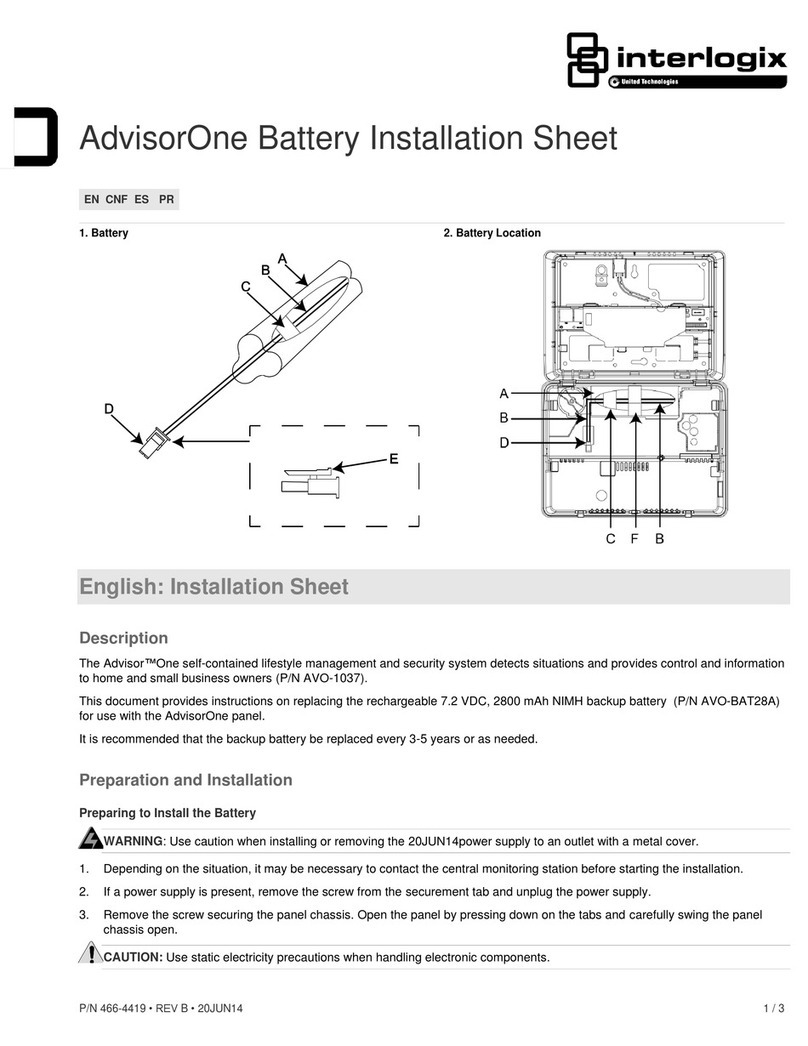
United Technologies
United Technologies Interlogix AdvisorOne Assembly instructions
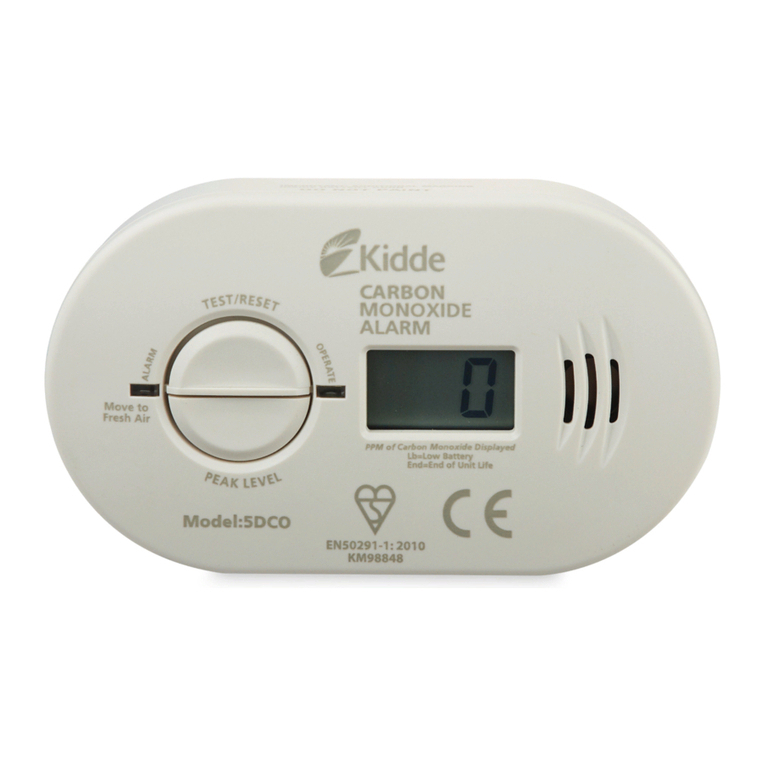
United Technologies
United Technologies Kidde 5CO User manual

United Technologies
United Technologies Interlogix AdvisorOne Assembly instructions

United Technologies
United Technologies interlogix AS500 Series Assembly instructions
